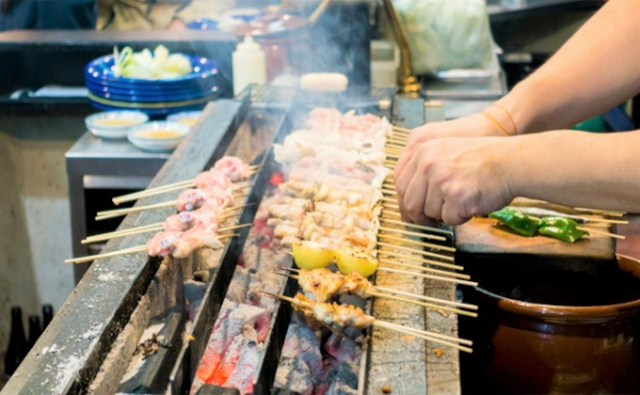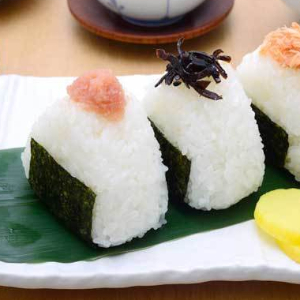Yesterday, I presented a quick refresher on styles of Japanese cuisine that some or many of us already knew or had heard about. But that’s just the beginning! Today, I’ll bring in a whole raft of dishes and cooking styles that Japanese folks love, but which aren’t well known outside of the island nation…
 Yakitori : Prepared in large batches on street grills or in Japanese
Yakitori : Prepared in large batches on street grills or in Japanese
Fast Food restos. Usually based on marinated Chicken…
Try not to drool as we discover some classic Japanese treats more of the world should know about!
Our menu for today…
The following are, once again, are selections from the Japan Centre master web page on cooking styles and key ingredients:
Tempura is a style of Japanese Preparation which many of us have heard of, but which – I’ve discovered – just as many confuse with Panko Breading. If you’re lucky, we’ll discuss the differences at a later date. If you enjoy crispy fried foods, then you will love tempura. Tempura are pieces or slices of meat, fish, and/or vegetables that have been covered in a special tempura batter and deep fried until they become crunchy and pale gold in colour. Unlike in the UK, where battered foods tend to be made from meats and fish, tempura tends to be made from either small shellfish like prawns, or vegetables like green beans, pumpkin, daikon mooli radish, and sweet potato. Tempura can be eaten by itself (perhaps with a little grated daikon and a small dish of tsuyu for dipping), or served on top of rice bowls or noodle soups.
Yakitori: While folks in the UK and elsewhere might pick up a serving of chips or a hot dog during a sports match, the Japanese will pick up some yakitori. With a name literally meaning ‘barbecued chicken’, yakitori (see photo, above) are small skewers of bite-size chicken pieces seasoned with salt or brushed with a sauce, or tare, of mirin rice wine, soy sauce, sake alcohol, and sugar. There are many different types of yakitori, but the most common varieties are momo (chicken thigh), negima (chicken and spring onion), and tsukune (chicken meatballs).
Donburi: This rice bowl dish is almost as popular as ramen in Japan and a common lunchtime choice among busy Japanese workers. Donburi is made by preparing (normally by simmering or frying) various meat, fish and vegetables and serving over steamed rice in large bowls (also called ‘donburi’). While donburi can be made using just about any assortment of ingredients, the most common types include oyakodon (simmered chicken, egg, and green onion), gyudon (sliced beef and onion simmered in a soy sauce soup base), tendon (fried tempura pieces drizzled in tsuyu), and katsudon (breaded and deep-fried pork cutlets, or tonkatsu, simmered in tsuyu with onion and egg).
Tamagoyaki is simply a Japanese Folded Omelet. A versatile delicacy that can be enjoyed for breakfast, lunch, or dinner, tamagoyaki (which literally means ‘cooked egg’) is a Japanese omelette made by sequentially cooking and rolling up several layers of beaten egg (sometimes seasoned with soy sauce and/or sugar). A freshly cooked tamagoyaki looks like a rolled up crêpe, which can then be sliced up and eaten by itself (often this is how it is eaten at breakfast) or used a topping or filling in sushi. A tamagoyaki-topped nigiri sushi is often eaten in sushi bars as the final course, as the tamagoyaki has a slight sweetness that makes it almost dessert-like.
Tonkatsu pork cutlets are one of the many yoshoku, or ‘western-style’ foods, that were originally introduced to Japan by Europeans. Like most other yoshoku foods, the Japanese took the original tonkatsu and made it their own. Today, tonkatsu is made by coating pork chops in crisp panko breadcrumbs and deep-frying them until they are golden brown in colour. They are normally served drizzled in fruit-and-vegetable based tonkatsu sauce with shredded cabbage and other crisp salad greens on the side. Tonkatsu are also often enjoyed as part of a bento boxed lunch, in a Japanese curry (known as ‘katsu curry’), or as a sandwich filling.
Nikujaga: A flavoursome savoury dish of meat, potatoes and assorted vegetables simmered in soy sauce, sake, mirin and sugar, Nikujaga meat and potato stew is one of a collection of Japanese dishes called ‘nimono’ (meaning ‘simmered things’). Although nikujaga is available in plenty of Japanese restaurants, it is also considered a homely dish that differs in flavour from household to household. For an authentic Japanese nikujaga experience, therefore, the best thing to do is get invited to a Japanese friend’s house and put in a request with the family chef.
Yakisoba: It is virtually impossible to attend a summer festival in Japan and not come across a yakisoba stand. Yakisoba is a fried noodle dish made by barbecuing or stir-frying a combination of noodles, sliced cabbage, pork, carrot and other vegetables, and a barbecue style yakisoba sauce. During the summer festivals large piles of these ingredients are thrown onto an outdoor hotplate and barbecued, but yakisoba can also easily be made at home using a large frying pan or wok. ‘Yakisoba’ means ‘cooked soba’, but unlike other soba noodles, the noodles used in yakisoba do not contain any buckwheat.
Onigiri: Like the sandwich could be considered the original portable food of British cuisine, the onigiri rice ball (see photo, top of page) is the original portable food of Japan. Also known as ‘omusubi’, ‘nigirimeshi’, or just ‘rice balls’, onigiri are portions of Japanese rice, normally with a filling in the centre, that have been moulded into triangular or cylindrical shapes before being wrapped in nori seaweed. Onigiri have been enjoyed in Japan for hundreds of years, and most Japanese convenience stores nowadays sell a great range of onigiri for 100-150 yen (£0.75-£1.12) a piece. Popular onigiri fillings include umeboshi pickled plums, seasoned seaweed, tuna mayonnaise, and teriyaki chicken.
Takoyaki: As far as Japanese street vendor foods are concerned, few are more notorious than takoyaki. Also known as ‘octopus balls’ or ‘octopus dumplings’, this delicacy is cooked using a special hot plate with rows of half-spherical moulds. Each of the moulds is filled with a savoury batter mixture before a bite-size piece of tako octopus meat is inserted into the middle. The takoyaki are turned with a pick or skewer every minute or so to ensure an evenly-cooked outside and a perfect ball-shaped dumpling in the end. Takoyaki are typically served in lots of six, eight or ten, brushed with a sweet/savoury takoyaki sauce and topped with mayonnaise, aonori seaweed and katsuobushi bonito fish flakes.
Wagashi: The most authentic way to finish off a Japanese meal or matcha tea ceremony is with wagashi. Wagashi are traditional Japanese sweets , invented during the Edo period and influenced by prevalent Japanese ingredients and flavours. Most wagashi are made using only a handful of select ingredients, including mochi rice cakes, anko paste, kanten (agar; a vegetarian thickener similar to gelatine), chestnuts, and sugar. The most popular wagashi include dango (sweet mochi balls on skewered sticks, often served with sugar syrup), daifuku (mochi rice stuffed with anko), dorayaki (anko sandwiched between two thick pancakes), and yokan (blocks of anko hardened with kanten and sugar).
There you go…
I know that’s a lot digest in just one sitting, but it’s still just the tip of the iceberg! Browse the Japan Centre website for hundreds of pages of product descriptions and authentic Japanese recipes.
Our thanks to the Japan Centre …
… For the use of their concise, delicious descriptions of the cooking styles and dishes presented today.
Disclaimer: I’ve relied heavily on the Japan Centre website as a resource over the past few days, not because it was easy, or because they paid me some kind of special consideration (they didn’t). It’s simply the best, most complete reference on Japanese cookery I’ve found on the web.
Tip: If you simply can’t find an ingredient specified in any Japanese recipe you’re trying out, and no substitution is recommended, check out the Japan Centre website. They have more than 3,000 authentic Japanese ingredients in stock, and can send to most places, depending on the destination spot’s regulations on importing Japanese/foreign foods.
~ Maggie J.

